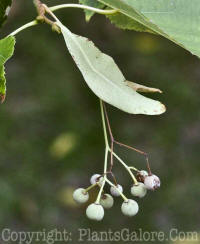|
 The two most recognized common names
for this species are linden and basswood. In the home
landscape, the most common example is the little leaf
linden,
Tilia cordata, which is a native of
Europe. In woodlots or older landscapes in the United States, a
large native tree,
Tilia americana, is called the
basswood. Although these two are the most commonly grown
in America, there are several other species from Europe
and
Asia. The two most recognized common names
for this species are linden and basswood. In the home
landscape, the most common example is the little leaf
linden,
Tilia cordata, which is a native of
Europe. In woodlots or older landscapes in the United States, a
large native tree,
Tilia americana, is called the
basswood. Although these two are the most commonly grown
in America, there are several other species from Europe
and
Asia.
 All of the lindens have alternate
leaves which are nearly heart shaped. The flowers are
unique but not very showy. The key characteristic is
that they have a separate little "leaf"
(actually a bract) on the stem of
the blossom. The blooms which appear in early June, can
be fragrant and are very attractive to honeybees. All of the lindens have alternate
leaves which are nearly heart shaped. The flowers are
unique but not very showy. The key characteristic is
that they have a separate little "leaf"
(actually a bract) on the stem of
the blossom. The blooms which appear in early June, can
be fragrant and are very attractive to honeybees.
The American basswood is not
generally introduced in the home landscape since it
becomes a rather large, coarse textured tree. The leaves
are quite large and can be a mess in the fall. Usually
when these are seen in the landscape, it is because the
tree was already there when the house was built.
On the other hand, the little leaf
linden is a fine landscape or curbside tree. It does not
grow nearly as large as the basswood and its small
leaves give a more moderate texture. Their foliage
usually turns a bright yellow before it drops in the
fall while the basswoods tend to turn brown.
There is one potentially major
problem with the little leaf linden. If your area is
bothered by
Japanese beetles, you should be aware that
lindens are high on their list of foot sources. In bad
infestations of Japanese beetles, the top of the tree's
canopy will turn brown by the end of the summer due to
the skeletonizing of the leaves. Although this usually
does not cause a serious problem for the life of the
tree, it is not very attractive. So, be aware of this
problem if Japanese beetles are common where you live.
There are several other species of
Tilias but they are not usually found in nurseries
and, therefore, in home landscapes. Some of them are not
suitable for such a use.
American
Lindens: T. americana, T.
heterophylla, T. caroliniana, T. floridana, T. neglecta
and T. monticola originated in North America with
the most common being T. americana. Because of
their mature tree size, leaf size and coarse texture,
none of these has been deemed a suitable alternative to
the little leaf linden for landscape use.
European
Lindens: Two species of small sized lindens, T. europaea and
T. vulgaris have been used in
some gardens in
Europe and the U.K. Over time, it has
been determined that these trees should not be used in
the home landscape. They tend to send up a lot of
suckers from the root system and are bothered by aphids
most summers.
Asiatic
Lindens: T. chinensis and T. mongolica
are a couple of smaller sized lindens that might be
useful in the landscape. However, they do not seem to
have any special features that would recommend them over
the little leaf linden so there isn't much interest in
developing them for the nursery trade at this point.
|